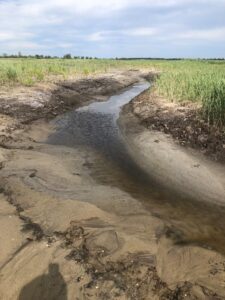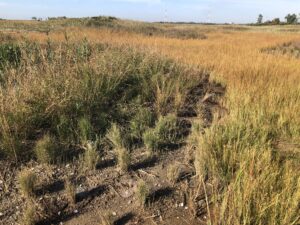Modified from The sparrow that speaks for the marsh | U.S. Fish & Wildlife Service (fws.gov)
Great Meadows Marsh, part of Stewart B. McKinney National Wildlife Refuge in Connecticut, was recently restored to improve both marsh health and Saltmarsh Sparrow populations. The USFWS, Audubon Connecticut, Connecticut Department of Energy and Environmental Protection, and National Oceanic and Atmospheric Administration have restored over 30 acres of Great Meadows marsh through a $4 million project, with additional funding from the Environmental Protection Agency and The Nature Conservancy, among others.

Creating new channel. Audubon CT
The project, which began in October 2021, focused on restoring salt marsh habitat through established techniques to improve hydrology and increase elevation, like removing embankments and restoring tidal channels. However, in a 4-acre patch where sparrows currently nest, managers saw both the need and opportunity to do something different. With relatively few nesting sparrows remaining there, the site was considered to be a perfect spot to test innovative new restoration techniques.
“We didn’t want to disturb any nesting birds, but we also were seeing this area rapidly transitioning away from high marsh, and most of the nests out here failed due to flooding,” said Suzanne Paton, wildlife biologist with the Service’s Ecological Services Southern New England Coastal Program who supported the restoration project.
Paton and the rest of the team decided to add islands of higher elevation called hummocks within the existing marsh platform. The idea was to create new patches of high marsh with appropriate flooding frequency for successful sparrow nests around existing nesting areas that currently flood too frequently. Crews identified the lowest sections of marsh and placed new sediment—over a foot high in places – on the existing marsh platform to bring the elevation back to high-marsh levels. Then, teams planted vegetation, experimenting with spacing and species in each plot to learn how sparrows use the marsh and respond to changes.

Some Sparrows were observed in newly created hummocks. Audubon CT
Franco Gigliotti, a doctoral student at University of Connecticut spent his summer in the marsh, monitoring sparrow nests and observing how the birds used the recently restored space. After year one, few answers are clear. Gigliotti observed birds foraging on the hummocks, but none actively nested on these new landscape features this year. Within the surrounding area Saltmarsh Sparrows nested but the vast majority of them failed, mostly due to premature flooding. These results were expected and, unfortunately, flooding remains the driving cause of decline for the species globally. “That level of failure is what we see on nearly every site where we study these birds, so it’s not just a Great Meadows Marsh thing, and that’s true even in our ‘good’ sites too,” Gigliotti said. While sparrows did not yet use the hummocks at this site, the installation of the hummocks did not deter them from using the space nearby to nest, which is promising for restoration efforts like these.
The researchers accept that climate change is going to alter some salt marshes irreversibly, but they hope restorations like the one at Great Meadows Marsh can be lifelines for sparrows and marshes, countering the harm humans have caused, either directly through mismanagement or indirectly through greenhouse gas emissions. They speculate that the right interventions can be the boost marshes need to get past current challenges. From there, natural processes can take hold, making the marshes inherently more resilient to rising sea levels and storms, protecting the sparrows and nearby communities.

